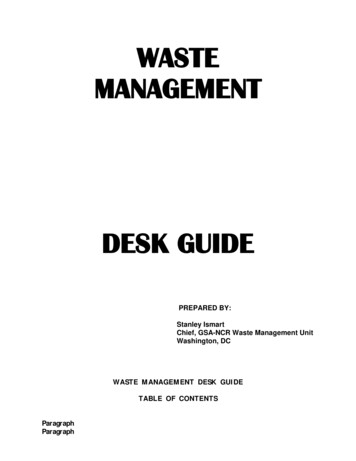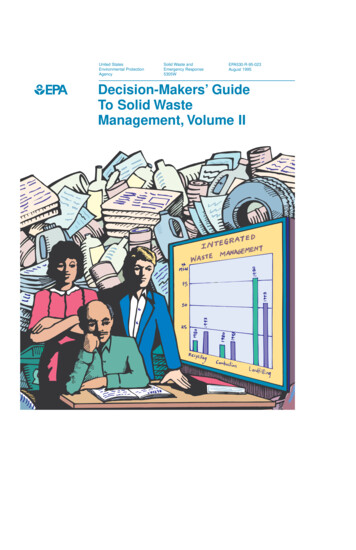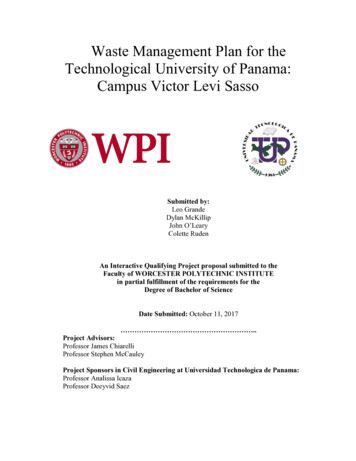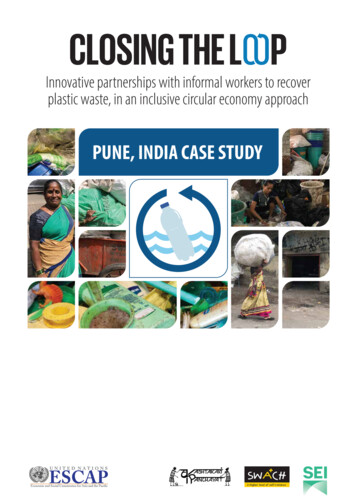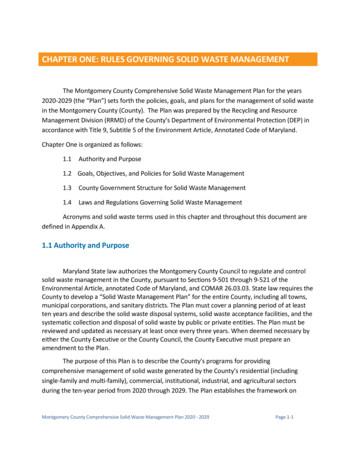
Transcription
CHAPTER ONE: RULES GOVERNING SOLID WASTE MANAGEMENTThe Montgomery County Comprehensive Solid Waste Management Plan for the years2020-2029 (the “Plan”) sets forth the policies, goals, and plans for the management of solid wastein the Montgomery County (County). The Plan was prepared by the Recycling and ResourceManagement Division (RRMD) of the County’s Department of Environmental Protection (DEP) inaccordance with Title 9, Subtitle 5 of the Environment Article, Annotated Code of Maryland.Chapter One is organized as follows:1.1Authority and Purpose1.2 Goals, Objectives, and Policies for Solid Waste Management1.3County Government Structure for Solid Waste Management1.4Laws and Regulations Governing Solid Waste ManagementAcronyms and solid waste terms used in this chapter and throughout this document aredefined in Appendix A.1.1 Authority and PurposeMaryland State law authorizes the Montgomery County Council to regulate and controlsolid waste management in the County, pursuant to Sections 9-501 through 9-521 of theEnvironmental Article, annotated Code of Maryland, and COMAR 26.03.03. State law requires theCounty to develop a “Solid Waste Management Plan” for the entire County, including all towns,municipal corporations, and sanitary districts. The Plan must cover a planning period of at leastten years and describe the solid waste disposal systems, solid waste acceptance facilities, and thesystematic collection and disposal of solid waste by public or private entities. The Plan must bereviewed and updated as necessary at least once every three years. When deemed necessary byeither the County Executive or the County Council, the County Executive must prepare anamendment to the Plan.The purpose of this Plan is to describe the County’s programs for providingcomprehensive management of solid waste generated by the County’s residential (includingsingle-family and multi-family), commercial, institutional, industrial, and agricultural sectorsduring the ten-year period from 2020 through 2029. The Plan establishes the framework onMontgomery County Comprehensive Solid Waste Management Plan 2020 - 2029Page 1-1
which current solid waste management activities are conducted and future programsimplemented.1.2Goals, Objectives, and Policies for Solid Waste ManagementThe County has adopted a hierarchy of solid waste management options (Figure 1.1).Source reduction of solid waste is the preferred management option. The hierarchy leads tominimizing the volume of waste that must be landfilled. This hierarchy recognizes theinterdependence of all elements of an integrated solid waste management system. The generalgoals of this Plan include the following features: The County must undertake all waste reduction measures to the extent practical andfeasible. All waste recycling measures should be implemented with available technologies andmarkets, which are not significantly more expensive than the waste disposal measuresthat would otherwise be needed. Technology, markets, and cost-effectiveness arereviewed regularly to expand recycling as new opportunities arise. The County will continue current disposal practices at least until 2026. To conserve capacity at the County’s solid waste acceptance and disposal facilities, theuse of these facilities is restricted to solid waste generated in the County.Montgomery County Comprehensive Solid Waste Management Plan 2020 - 2029Page 1-2
Figure 1.1 Montgomery County’s Solid Waste Management HierarchyThe County’s solid waste management programs and policies have created a system thatexceeds the State’s established recycling goals. The County’s solid waste management hierarchyis consistent with the State’s hierarchy. By shifting the focus of solid waste management to wastereduction and recycling, the County strives to reduce the solid waste remaining for disposal. Toreduce the County’s reliance on landfill capacity, ash generated at the RRF is beneficially reusedas a road base or alternative daily cover at a landfill outside the County.This solid waste plan is consistent with Objective 9 of the County’s comprehensive landuse plan, “General Plan Refinement of the Goals and Objectives for Montgomery County (1993) 1“:Provide an adequate, self-sufficient, well-monitored, and ecologically sound system for themanagement of Montgomery County’s solid wastes.1 General Plan Refinement of the Goals and Objectives for Montgomery County, The Maryland-National Capital Park And Planning Commission,December 1993Montgomery County Comprehensive Solid Waste Management Plan 2020 - 2029Page 1-3
1.3County Government StructureThe County is a charter county of Maryland with a nine-member County Council and aCounty Executive. The County Executive drafts the Plan, its amendments and revisions, andrecommends solid waste legislation. The County Executive also administers the County solidwaste laws in Chapter 48 of the Montgomery County Code. After providing notice andconducting public hearings, the County Council adopts the Plan, its amendments and revisions,and approves other solid waste legislation. In 2020, County voters approved a ballot initiative toincrease the size of the County Council to eleven members. This increase will take effect with the2022 general election. Figure 1.2 shows an organizational chart of the County government.Montgomery County Comprehensive Solid Waste Management Plan 2020 - 2029Page 1-4
Figure 1.2 Montgomery County, Maryland Functional Organization ChartMontgomery County Comprehensive Solid Waste Management Plan 2020 - 2029Page 1-5
1.3.1 Primary Solid Waste Management ResponsibilityThe day-to-day management of the County’s integrated solid waste management systemand planning for solid waste management is the responsibility of the County’s DEP. DEP is underthe general supervision of a director appointed by the County Executive and confirmed by theCounty Council. The DEP monitors land, air, water, and other environmental quality concernsrelated to solid waste management activities. Within DEP, the Recycling and ResourceManagement Division (RRMD) ensures that all municipal solid waste is handled correctly anddisposed of through the enforcement of State regulations and Chapter 48 of the MontgomeryCounty Code.1.3.2 Other Executive Branch Departments that Manage Solid WasteThe Department of Housing and Community Affairs (DHCA) enforces portions of Chapter48 by ensuring the removal of abandoned vehicles and solid waste from residential areas.The Police Department receives and disposes of abandoned vehicles. The Division ofAnimal Services contracts for the collection and disposal of dead animals.The County Department of Transportation (DOT) vacuums leaves from public rights-ofways from November through January with the Leaf Collection District. The Leaf CollectionDistrict lies mostly within Subdistrict A, with a small portion in Subdistrict B, but the boundariesare not contiguous. DOT also collects roadside litter and conducts clean-up operations followingsignificant storm events.The Department of Fire and Rescue Services (DFRS) reviews solid waste acceptancefacilities concerning the potential for fire and other hazards. DFRS also supports DEP in controlledhazardous substances (CHS) spill emergencies.1.3.3 Other Agencies that Manage Solid WasteOther agencies have the following roles in managing solid waste in the County anddeveloping the Plan.Montgomery County Comprehensive Solid Waste Management Plan 2020 - 2029Page 1-6
Maryland-National Capital Park and Planning CommissionThe Maryland-National Capital Park and Planning Commission (M-NCPPC) is a bi-Countyagency created by the General Assembly of Maryland to prepare, adopt, and amend land useplans for the physical development of the Maryland-Washington Regional District that includesmost of Montgomery and Prince George’s Counties. M-NCPPC provides DEP with informationand assistance as necessary during the preparation of the Plan. Pursuant Section 9-515(e) of theEnvironment Article, Annotated Code of Maryland, the County Council must submit the final draftof any revision or amendment of the Plan to M-NCPPC for their recommendations at least 30days before the date set for the public hearing on the Plan. The County Council requested MNCPPC comments on February 12, 2021, and no comment was received.Washington Suburban Sanitary Commission (WSSC Water)WSSC Water is a bi-county agency created by the General Assembly of Maryland. WSSCWater is responsible for planning, designing, constructing, operating, maintaining waste andsewerage systems, and acquiring facility sites and rights-of-way to provide potable water andsanitary sewer services within the Washington Suburban Sanitary District that includes most ofMontgomery and Prince George’s Counties. WSSC Water provides the executive branch withinformation and assistance as necessary during the preparation of the Plan. Pursuant Section 9515(e) of the Environment Article, Annotated Code of Maryland, the County Council must submitthe final draft of any revision or amendment of the Plan for recommendation to WSSC Water atleast 30 days before the date set for the public hearing on the Plan. The County Councilrequested WSSC Water comments on February 12, 2021, and no comment was received.Maryland Environmental ServiceMaryland Environmental Service (MES) is an agency of the State of Maryland and a publiccorporation that provides environmental management services to public and private entities.MES receives no direct State appropriation and is required to provide its services on a fee-forservice basis. MES assists the County in the operation of several elements of the County’s solidwaste management system, including the operation of the Materials Recovery Facility (MRF), theCounty Yard Trim Composting Facility, and recycling activities taking place at the County ShadyGrove Processing Facility and Transfer Station (Transfer Station).Montgomery County Comprehensive Solid Waste Management Plan 2020 - 2029Page 1-7
Northeast Maryland Waste Disposal AuthorityThe Northeast Maryland Waste Disposal Authority (NMWDA) was created by the GeneralAssembly of Maryland to assist political subdivisions, public entities, and the private sector inwaste management and the development of adequate waste disposal facilities to accommodateregional requirements for the disposal of solid waste. NMWDA financed the cost of designingand constructing the County’s RRF and related transportation improvements necessary for theproject. The County has a Waste Disposal Agreement with NMWDA for the disposal of nonrecycled waste.Waste Reduction and Recycling by Government AgenciesAll federal, state, and County agencies must comply with all waste reduction and recyclingmandates and requirements imposed on County businesses. Each agency should track its annualwaste generation and recycling rates and be prepared to report to the County Executive, CountyCouncil, and the RRMD on measures undertaken to reduce the amount of trash produced, reuseof materials, and recycling activities.In accordance with Resolution 15-313, regarding environmental policy, each Countyagency or department must appoint Environmental Policy Coordinators, submit environmentalaction plans outlining their goals, including annual reports on their accomplishments, andpromote environmentally responsible business practices. The County expects all federal andstate agencies located in the County to abide by County waste reduction and recyclingregulations.Montgomery County Comprehensive Solid Waste Management Plan 2020 - 2029Page 1-8
1.4Laws and Regulations Governing Solid Waste ManagementFederal, state, and local laws and regulations govern solid waste management in theCounty. However, federal authority in the County is limited. Generally, federal authority toimplement federal laws and regulations is given to the state, and the County’s solid wasteprogram and ordinances must meet or exceed the solid waste laws and regulations of the state.1.4.1 Federal Laws and RegulationsResource Conservation and Recovery Act (RCRA) of 1976:A primary objective of this Act, as amended, is to promote recycling and reuse ofrecoverable materials. RCRA Subtitle D focuses on State and local governments as the primaryentities that plan, regulate, and implement the management of non-hazardous solid waste, suchas household garbage and non-hazardous industrial solid waste.RCRA Subtitle C establishes a Federal program to manage hazardous wastes from creationto proper disposal to ensure that hazardous waste is handled to protect human health and theenvironment.Comprehensive Environmental Response, Compensation, and Liability Act (CERCLA)):Establishes programs for the identification and remediation of waste disposal sitescontaining hazardous substances; establishes standards for clean-up efforts and disposal ofwaste; and provides a mechanism for assigning liability for contaminated sites.Clean Water Act (CWA):Section 402 of this act establishes the National Pollutant Discharge Elimination System(NPDES) program to address the discharge of wastewater and runoff from solid wastemanagement facilities into surface waters. The construction of facilities that may impact anyrivers, lakes, marshes, swamps, or wetlands of the United States is addressed by Section 404,administered by the Army Corps of Engineers. Section 405 addresses the disposal of wastewatertreatment biosolids.Clean Air Act (CAA):Title I of the CAA addresses emissions from landfills and authorizes regulations on thecollection and control of those emissions. Title V of the CAA addresses the potential-to-emitpollutants and authorizes permitting regulations for major polluters. Landfill facilities are subjectto Title I and are required to obtain a Title V permit, in addition to any facility that is a “majorsource” of pollutants.Montgomery County Comprehensive Solid Waste Management Plan 2020 - 2029Page 1-9
Safe Drinking Water Act (SDWA):Establishes maximum contaminant levels for parameters included in groundwatermonitoring programs.Federal Emergency Management Act (FEMA):Prohibits siting of landfills within the 100-year floodplain (Subtitle D allows for anexception if the unit will not restrict the flow on the 100-year flood, reduce the temporarystorage capacity of the floodplain, or result in washout of solid waste).Public Utilities Regulatory Policies Act (PURPA):Encourages co-generators and small power producers, such as municipal solid wastecombustors, to supplement their existing electrical utility capacity. The Federal Energy RegulatoryCommission is responsible for implementing regulations and setting limits on the power output ofthese facilities.CFR, TITLE 40, SUBCHAPTER IPart 240:Guidelines for the Thermal Processing of Solid WastesMinimum performance levels for MSW incinerators.Part 243:Guidelines for the Storage and Collection of Residential, Commercial, andInstitutional Solid WasteMinimum performance levels for solid waste collection operations. Issues addressedinclude storage safety and equipment and collection frequency and management.Part 246:Source Separation for Materials Recovery GuidelinesMinimum actions are recommended to recover resources from solid wastes, includinghigh-grade paper, residential materials, and corrugated containers.Part 247:Guidelines for the Procurement of Products that Contain Recycled MaterialsRecommended guidelines only. Procedures and specifications for procurement ofproducts to increase the use of recycled material.Part 255:Identification of Regions and Agencies for Solid Waste ManagementProcedures for the identification of regional solid waste management planningdistricts.Montgomery County Comprehensive Solid Waste Management Plan 2020 - 2029Page 1-10
Part 256:Guidelines for Development and Implementation of State Solid Waste ManagementPlansGuidelines for development and implementation of state solid waste managementplans.Part 257:Criteria for the Classification of Solid Waste Disposal Facilities and PracticesCriteria to determine which solid waste facilities pose a reasonable probability ofadverse effects on health or the environment. Facilities in violation will be consideredopen dumps. It does not apply to municipal landfills (covered under Part 258).Part 258:Criteria for Municipal Solid Waste Landfills (Subtitle D Regulations)Establishes minimum national criteria for the design and operation of MSW landfills.Includes location restrictions, operating criteria, design criteria, groundwatermonitoring, corrective action, closure and post-closure, and financial assurancecriteria. Design standards apply only to new landfills and lateral expansions of existingfacilities.Part 260:Hazardous Waste Management System - GeneralProvides definitions and a general overview of Parts 260 through 265.Part 261:Identification and Listing of Hazardous WasteProvides identification of those materials which are subject to regulation ashazardous wastes under Parts 270, 271, and 124.Part 264:Standards for Owners and Operators of Hazardous Waste Treatment,Storage and Disposal FacilitiesEstablishes minimum national standards for the management of hazardous wastes.Part 265:Interim Status Standards for Owners and Operators of Hazardous WasteTreatment, Storage, and Disposal facilitiesEstablishes minimum national standards that define the management of hazardouswastes during the period of interim status and until the certification of post-closureor closure of the facility.Montgomery County Comprehensive Solid Waste Management Plan 2020 - 2029Page 1-11
Part 266:Standards for the Management of Specific Hazardous Wastes and Specific TypesHazardous Waste Disposal SitesEstablishes minimum national standards for the recyclable materials used in amanner to constitute disposal, hazardous waste burned for energy recovery, used oilburned for energy recovery, recyclable material used for precious metal recovery,and spent lead-acid batteries being reclaimed.Part 270:EPA Administered Permit Programs: The Hazardous Waste Permit ProgramApplication requirements, standard permit conditions, monitoring, and reportingrequirements for EPA permitting for the treatment, storage, and disposal ofhazardous waste.Part 271:Requirements for Authorization of State Hazardous Waste ProgramsIdentifies the requirements that state programs must meet to fulfill interim and finalauthorization as well as the procedures EPA uses to approve, revise, and withdrawapproval of state programs.Part 272:Approved State Hazardous Waste ProgramsEstablishes the applicable state hazardous waste management programs.Part 273:Standards for Universal Waste ManagementEstablishes the requirements for managing batteries, pesticides, mercury-containingequipment, and lamps.Part 503:Standards for the Use or Disposal of Sewage SludgeEstablishes standards, which consist of general requirements, pollutant limits,management practices, and operational standards for the final use or disposal ofsewage sludge generated during domestic sewage treatment in treatment works.Montgomery County Comprehensive Solid Waste Management Plan 2020 - 2029Page 1-12
1.4.2 Maryland Laws and RegulationsThe primary laws of the State of Maryland that relate to solid waste management arecontained in the Local Government Article, the Environment Article , and the Natural ResourcesArticle. Pursuant to Section 10-317(a)(2) of the Local Government Article, charter counties havethe power to enact local laws concerning the disposal of wastes. Title 9 of the EnvironmentArticle contains provisions for the planning and permitting of solid waste management andrelated facilities. It also provides for the regular submission of solid waste management plans bythe counties, sets forth the minimum requirements of such plans, provides for a recycling office,and requires counties to submit a recycling plan. Notable sections include the following: Section 9-204 defines the requirements for Refuse Disposal Permits issued by the MDE; Section 9-210 requires that specific wastes which are authorized for disposal in rubblelandfills in the County be defined in the Plan before issuance of a permit by the State andprovides prerequisites for the issuance of permits for refuse disposal systems; Section 9-211 describes the financial assurance requirements relating to the siting of solidwaste facilities; Section 9-228 pertains to the storage, recycling, and disposal of scrap tires through stateefforts. Regulations for this program are in the Code of Maryland Regulations (COMAR)26.04.08; Section 9-1703 requires that each county submit a recycling plan to the state when thePlan is submitted. This section also defines specific information to be included in bothplans; Section 9-1708 establishes requirements for a natural wood waste recycling facility.The Natural Resources Article also contains several sections that relate to solid wastemanagement planning. Notable provisions are included in Title 3, Subtitle 1 (MarylandEnvironmental Service), Title 9, Subtitle 4 of the Environment Article (Hazardous Waste FacilitySiting Program), and Title 3, Subtitle 9 (Northeast Maryland Waste Disposal Authority).The primary regulations governing solid waste management are contained in COMAR'sTitle 26 (Department of the Environment). The pertinent sections of Title 26 are as follows: Subtitle 03 – Water Supply, Sewerage, Solid Waste, and Pollution Control Planning andFunding, which pertains to the development of county Comprehensive Solid Waste ManagementPlans;Montgomery County Comprehensive Solid Waste Management Plan 2020 - 2029Page 1-13
Subtitle 04 – Regulation of Water Supply, Sewage Disposal, And Solid Waste, whichcontains general provisions related to all aspects of solid waste management; Subtitle 11 - Air Quality, which contains requirements governing incinerators and asbestosdisposal; and Subtitle 13 - Disposal of Controlled Hazardous Substances, which contains requirementsfor the management of CHSs.The text below lists the relevant sections of the Annotated Code of Maryland and otherstate regulations that affect solid waste management.Chesapeake Bay Critical Area Protection Program (1984):Controls human intervention in the Bay area.Composting Act (1992):Includes composting in the definition of recycling. Requires that county recycling plansaddress composting issues and bans loads of yard materials collected separately from trash frombeing landfilled effective in 1994.Electronics Recycling Program (2007):Mandates that manufacturers of certain electronics devices (computers, televisions, etc.)contribute payments toward a fund for local government electronics recycling programs or thatsuch manufacturers establish their own electronics recycling collection programs. Authorizescounties to address the subject of electronics recycling in their recycling plans.Land-Clearing Debris Landfills – Amount of Security (1990):Addresses the number of bonds required as security for each acre of land-clearing debrislandfills.Maryland Air Quality Control Act (1989):Allows the adoption of rules for air pollution control, sets emission standards and airquality control areas and requires training for municipal solid waste incinerator operators.Maryland Environmental Service Act (1970):Creates the Maryland Environmental Service to manage service regions that were createdto deal with issues affecting the State’s water supply, wastewater purification, and solid wastemanagement.Montgomery County Comprehensive Solid Waste Management Plan 2020 - 2029Page 1-14
Maryland Landfill Financial Assurance Law (1997):Sets forth financial assurance requirements for landfills in conformance with therequirements of federal regulations.Maryland Landfill Siting Law (1994):Describes the requirements for public hearings regarding landfill siting and addressespermitting requirements and security requirements. Explains the requirements for submittingplans and documents necessary to conduct a technical review and approve proposed facilities.Maryland Recycling Act (2012):House Bill 929 (2012) amended the rates to 35 percent for Counties with a populationgreater than 150,000 or 20 percent for a county with less than 150,000. The law requires fullimplementation by December 31, 2015.Maryland Senate Joint Resolution 6 (2000):Sets a voluntary statewide goal of 40 percent waste diversion by 2005, with a credit of upto 5 percent for jurisdictions engaged in specified waste prevention activities. “Waste diversion”is defined as the recycling rate plus waste prevention credit.Mandatory recycling rates established by the Maryland Recycling Act of 1988 remain ineffect.Maryland State Implementation Plan (SIP) (Ongoing):Limits emissions from specific pollutant sources to prevent air quality from falling belowNational Ambient Air Quality Standards (NAAQS).Maryland Nonpoint Source Pollution Control Laws (1990-1994):Allows for the adoption of criteria and procedures by counties and soil conservationdistricts to implement soil erosion control programs and for counties and municipalities toimplement stormwater management programs.Maryland Used Oil Recycling Act (1997):Requires MDE to develop programs to educate the public on oil recycling and designateused oil collection facilities. It also prohibits the disposal of used oil into sewers, drainagesystems, or natural waters.Montgomery County Comprehensive Solid Waste Management Plan 2020 - 2029Page 1-15
Maryland Wastewater Treatment Law (1987):Requires permits before installing, altering, or extending a water supply system or refusedisposal system (including a landfill, waste transfer station, incinerator, or other waste processingfacility).Mercury Oxide Battery Act (1992):Makes mercury oxide battery manufacturers responsible for collecting, transporting, andrecycling, or disposal of batteries sold or offered for promotional purposes in the state.Natural Wood Waste Recycling Act (1991):Establishes the requirements for wood waste recycling in Maryland, authorizes theDepartment of the Environment to adopt additional regulations governing recycling facilities, andrequires a permit to operate these wood waste facilities created after July 1, 1992.Newsprint Recycled Content Act (1991):Regulates newsprint recycling by imposing specified recycling content percentagerequirements on the Maryland newspaper industry. It was amended in 2006 to measurecompliance based on a rolling three-year average.Nickel Cadmium (NICD) Battery Act (1995):Regulates the storage, transportation, and destination of nickel-cadmium batteries.Nontidal Wetland Regulations (1990):Prevents net loss of non-tidal wetlands by establishing a stringent permitting process.Northeast Maryland Waste Disposal Authority (1980):Creates and establishes the powers of the Northeast Maryland Waste Disposal Authority.Plastic Material Code (1991):Regulates that rigid plastic containers or bottles may not be distributed for sale in thestate unless appropriately labeled, indicating the plastic resin used to produce them.Public School Plans (2009):An Act requiring a county recycling plan to address the strategy for the collection,processing, marketing, and disposition of recyclable materials from county public schools.Montgomery County Comprehensive Solid Waste Management Plan 2020 - 2029Page 1-16
Recycling – Apartment Buildings and Condominiums (2012):An Act requiring a county recycling plan to address the collection and recycling ofrecyclable materials from residents of apartment buildings and condominiums that contain ten ormore dwelling units by property owners or managers of apartment buildings and councils of unitowners of condominiums. Implements a reporting requirement for recyclable materialsgenerated at apartment buildings and condominiums that contain ten or more dwelling unitswhen applicable.Recycling – Composting Facilities Act (2013):Provides that a person may operate a composting facility only in accordance withspecified requirements, regulations, orders, and permits and requires the Department of theEnvironment to adopt regulations to establish a permit system for composting facilities.Recycling – Special Events (2014):An Act requiring a County Recycling Plan to address the collection and recycling ofrecyclable materials from special events by October 1, 2015. It was amended in 2017 to require acounty government to provide a written statement before issuing a certain permit for a specialevent after October 1, 2017.Recycling – Office Buildings (2019):An Act requiring a County Recycling Plan to address the collection and recycling ofrecyclable materials from buildings that have 150,000 square feet or greater office space byOctober 1, 2020.Scrap Tire Law (1992):Prohibits the disposal of scrap tires in landfills after January 1, 1994, and creates alicensing system to manage scrap tires. Establishes requirements for implementing a scrap tirerecycling system, licensing haulers, and collection facilities. Establishes the Tire Clean-Up andRecycling Fund.Sludge Application (1993):Regulates land application procedures for sludge to maintain public health.Telephone Directory Recycling Act (1991):Requires telephone directory publishers to meet specified recycling content percentage.Montgomery County Comprehensive Solid Waste Management Plan 2020 - 2029Page 1-17
Waste Reduction and Resource Recovery Plan for Maryland (2017):Creates a policy to minimize environmental impacts of materials management, conservein-State disposal capacity, make optimal use of resources and create an environmentally andeconomically sustainable system of materials management.Water and Sewage Plan Act (1983):Requires the preparation and submission of solid waste management plans by countiesand establishes the minimum requirements of such plans.Yard Waste Act (1994):Bans separately collected yard waste from disposal facilities after October 1994.COMAR Regulations:The principal regulations of the State of Maryland
1.3.1 Primary Solid Waste Management Responsibility The day-to-day management of the County's integrated solid waste management system and planning for solid waste management is the responsibility of the County 's DEP. DEP is under the general supervision of a director appointed by the County Executive and confirmed by the County Council.

